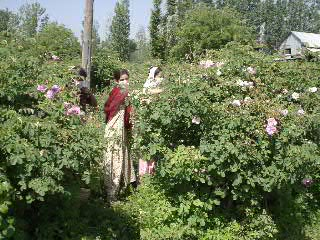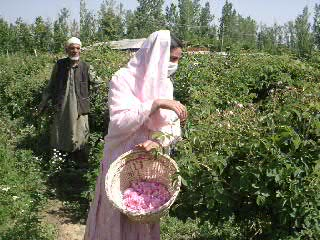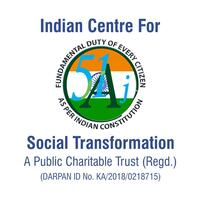
India success story of CSIR Technology absorption - efforts at grassroots - level developmental work
Cultivation of Aromatic and Medicinal plants
Cultivation and processing of aromatic and medicinal plants including mushrooms have opened new opportunities for income generation in rural sector. CSIR Institute of Integrative Medicine (IIIM) (formerly RRL) at Srinagar has developed and standardized cultivation and processing technologies in case of high value, low volume crops having climatic suitability and established national and international market. Prominent among them are lavender, rose, clarysage, rosemary, rose geranium and tagetes.
A number of experiments initiated both at field and laboratory level over the years have led to successful development of agro and processing technologies of these specialty crops which have a direct link with the farming sector of Kashmir valley. At the same time efforts were made to attract Government and private agencies to take up cultivation of rose and lavender in the neglected pockets under CSIR rural development programme. Such objectives were achieved by direct contact with the farming community, visits of scientists to farmers land. Training cum awareness programmes on cultivation and distillation of high value aromatic crops. Establishment of linkages with the user industries and providing quality planting material and extension folders in local languages. The scope of this socio economic programme was also enhanced under public private partnership programme.
True lavender is a versatile cash crop for temperate region of Kashmir, hilly areas of Himachal Pradesh and Uttrakhand. A new variety of true lavender (Lavendula angustifolia) evolved through vigorous selection having high content of lavender oil and high content of linalool and linalyl acetate (> 48%) was developed. The quality profile of lavender oil is at par with international standards and is being sold both in national and international markets and has been extended in the farmers land.
Lavender is an incredible and much sought after aromatic plant having significant position in the perfumery trade all over the world. It has multifarious uses and market outlets. Beside its use in fragrance applications, predominantly body care products, Lavender oil and Lavender water has substantial applications in alternative health care practices of aromatherapy. Pure oil can be used without a base oil. It can be blended with bergamot, clarysage, jasmine, lemon and rose oil to prepare many formulations for different ailments. It has a remarkable effect on the emotional and mental balance of human being.

Lavender can be suitable integrated with apple as an intercrop under Kashmir conditions thus permits increased harvest per unit, better economic returns for the farming community.
In Lavender, the initial investment is the plantation and processing for Lavender oil thereof which require a steam distillation unit.
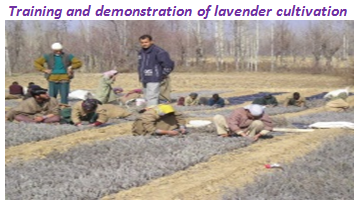
| Total herbage yield | 60 – 70 qtl / hac. |
| Oil recovery on pilot scale | 1 to1.6%. |
| Total Oil Yield | 60-70 kg / hac |
| Sale price of oil | Rs.2500 / Kg |
| Gross return | 1.50 – 1.75 lakhs |
| Cost of production | 0.50 – 0.60 lakh |
| Net profit / hac | 1.0 – 1.15 lakh |
(Rosa damascena Mill) commonly known as Damask rose (Gulab)is the most important source of rose products like rose oil, rose concrete, absolute and rose water. They are highly expensive base materials for perfumery, flavor, cosmetic, pharmaceutical and food industries. The oil has antibacterial, antidepressant, antispasmodic properties. It is a wonderful skin toner and anti-wrinkling agent. Rose oil is used for compounding and to give characteristic rose odour with distinctive floral tonality. Rose products have good demand in India as well in other countries.
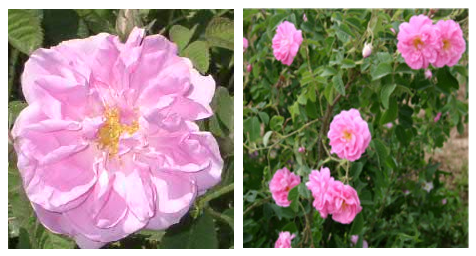
Besides rose oil other value added products are obtained from rose flowers. Rose attar is used in perfumery based on sandalwood or paraffin oil. Gul-e-Roghan is prepared from dry rose petals for making hair oils. Gul-kand is prepared by mixing fresh rose petals with sugar used as laxative and in Kashmiri Khawa. Rose hips are a good source of Vitamin C. Rose concrete is produced by extracting fresh rose flowers with the organic solvent, (Perfumery grade hexane). Rose absolute is prepared from rose concrete by refluxing with 90% alcohol followed by filtration and removal of undesired fats and solvent traces. Rose water of different grades is prepared by distilling rose petals. In India 60-70% damask rose is used for preparation of rose water used in religious ceremonies and as a coolant in soft drinks. Rose water and dry rose flowers are also used in traditional system of Indian medicine, sometimes they are also used as food adjuvants. Various rose preparations are being used as an astringent, tonic, mild laxative, antibacterial in the treatment of sore throat, enlarged tonsils, cardiac troubles, eye diseases, gall stones, cooling effect and as vehicle for other medicines.
Besides lavender and rose other aromatic plants like clarysage, rosemary, geranium, peppermint and tagetes can be also processed for essential oils. These aromatic plants have been selected on the basis of harvesting periods under temperate climatic conditions so that 6-7 essential oils and their value added products could be produced in one distillation plant. Thus this bio business is better protected from market fluctuations at national and international level.
| Economics | |
| Flower yield | 35-40 qtls / hac. |
| Oil recovery | 0.025 – 0.03 % |
| Oil yield | 0.75 – 1.0 kg |
| Sale price of oil | Rs. 2.25 lakhs / kg |
| Gross return | 1.68 – 2.25 |
| Cost of production | 0.60 – 0.70 lakhs |
| Net profit / hac | 1.08- 1.55 lakhs |
